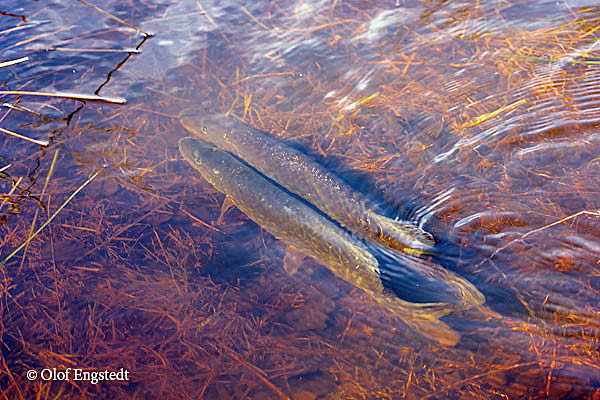Accurate timing of migration prolongs life expectancy in pike

Two northern pike (Esox lucius) returning to spawn in the stream where they were born. They will soon emigrate back to the Baltic Sea, where individuals originating from different streams coexist. Photo © Olof Engstedt
Pike is a widely distributed, long-lived and large keystone predatory fish species that breeds annually after becoming mature. In the Baltic Sea, some pike display homing behaviour and repeatedly migrate to spawn in the same stream where they were born. Migrating pike in the Baltic Sea thus offers interesting and rare opportunities to gain further understanding of the causes and consequences of variation in migratory timing among and within individuals.
Tibblin and collaborators from Linnaeus University (Kalmar, Sweden) studied arrival timing across six years of more than 2000 marked pike that migrated to a small spawning stream that flowed into the southwest of the Baltic Sea.
Lead-author Dr Petter Tibblin elaborates: “results show that individual migratory timing is consistent across years and that arriving too early or too late increases mortality. Individuals also continuously fine-tune their timing with increased experience, a behaviour that is similar to the trial-and-error method used by many mammals but previously not shown for fish”.
Results also shed some new light on the long-standing and intriguing issue of whether flexibility is adaptive such that it increases fitness, a topic that recently has received increased scientific attention although it has rarely been investigated empirically.
Study co-author professor Anders Forsman says: “we demonstrate that there is variation among individuals in the degree of flexibility (adjustments in migratory timing across years) and further establish that greater flexibility at early reproductive events improves life expectancy”
This research emphasizes the complex nature of animal behaviour, and advances our understanding of migratory behaviour. Co-author professor Per Larsson concludes: “that among individual variation and within-individual flexibility in migratory timing are associated with fitness suggest that these behaviours may also influence the viability of populations in the face of a rapidly changing world, and this should be considered in management programs”.
Petter Tibblin, Anders Forsman, and Per Larsson are members of the Linnaeus University Centre for Ecology and Evolution in Microbial model Systems, EEMiS. http://lnu.se/lnuc/eemis
Anders Forsmans personal webpage: http://lnu.se/personal/anders.forsman
Read the article:
Tibblin, P., Forsman, A., Borger, T. and Larsson, P. 2015. Causes and consequences of repeatability, flexibility and individual fine-tuning of migratory timing in pike. Journal of Animal Ecology, DOI: 10.1111/1365-2656.12439
Contact information:
Petter Tibblin, PhD, e-mail: Petter.Tibblin@LNU.se; phone: +46-(0)480-44 67 45; cellular phone: +46-(0)705-52 99 37
Anders Forsman, professor, e-mail: Anders.Forsman@LNU.se; phone: +46-(0)480-44 61 73; cellular phone: +46-(0)706-27 27 38
Per Larsson, professor, e-mail: Per.Larsson@lnu.se; phone: +46-(0)480-44 73 11
Pressofficer, Jonas Tenje+46 (0) 70 308 40 75
Pressofficer: Christina Dahlgren, +46-705 72 26 56, christina.dahlgren@lnu.se
http://onlinelibrary.wiley.com/doi/10.1111/1365-2656.12439/abstract Link to the article
Media Contact
All latest news from the category: Life Sciences and Chemistry
Articles and reports from the Life Sciences and chemistry area deal with applied and basic research into modern biology, chemistry and human medicine.
Valuable information can be found on a range of life sciences fields including bacteriology, biochemistry, bionics, bioinformatics, biophysics, biotechnology, genetics, geobotany, human biology, marine biology, microbiology, molecular biology, cellular biology, zoology, bioinorganic chemistry, microchemistry and environmental chemistry.
Newest articles

Properties of new materials for microchips
… can now be measured well. Reseachers of Delft University of Technology demonstrated measuring performance properties of ultrathin silicon membranes. Making ever smaller and more powerful chips requires new ultrathin…

Floating solar’s potential
… to support sustainable development by addressing climate, water, and energy goals holistically. A new study published this week in Nature Energy raises the potential for floating solar photovoltaics (FPV)…

Skyrmions move at record speeds
… a step towards the computing of the future. An international research team led by scientists from the CNRS1 has discovered that the magnetic nanobubbles2 known as skyrmions can be…





















